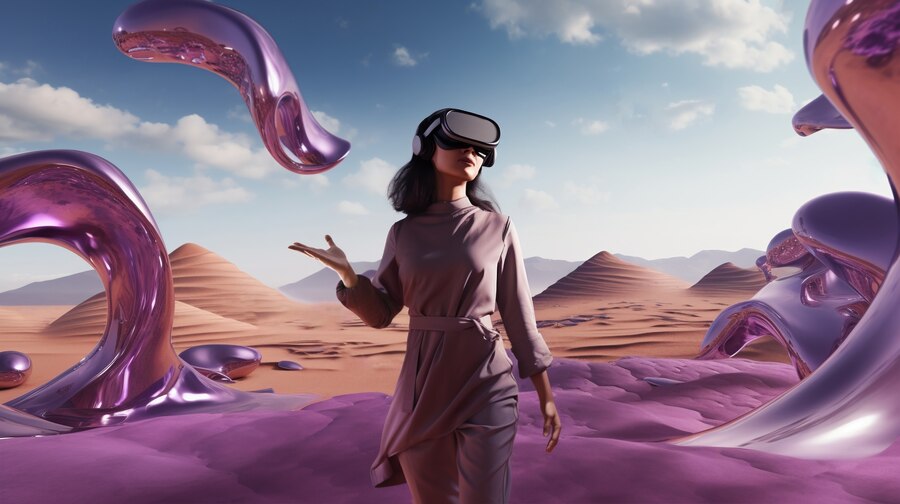Table of contents
The concept of the Evolution of the Metaverse has transcended its sci-fi origins to become one of the most talked-about technological developments of the decade. Once imagined as a futuristic digital playground, the Metaverse has rapidly evolved from a gaming and social interaction platform into a broad ecosystem with transformative potential across industries.
But what exactly is the Metaverse? How is it evolving, and what lies beyond the immersive games and virtual hangouts we currently associate with it? This article explores the past, present, and future of the Metaverse, highlighting its expanding role in work, education, commerce, healthcare, and beyond.
What Is the Metaverse?
The Evolution of the Metaverse refers to a shared, persistent virtual space that merges physical and digital realities. It encompasses a variety of technologies—augmented reality (AR), virtual reality (VR), blockchain, artificial intelligence (AI), and 3D virtual worlds—that together create an immersive and interactive experience.
Unlike a single app or platform, the Evolution of the Metaverse is an interconnected digital universe. Users can interact with one another, build digital assets, engage in commerce, attend events, and even work in this alternate dimension.
The Origins of the Metaverse
The term “Metaverse” was first coined in Neal Stephenson’s 1992 novel Snow Crash, where it described a digital universe accessible through VR headsets. Since then, the idea has been embraced and reimagined in pop culture, from The Matrix to Ready Player One.
In the real world, early forms of the Evolution of the Metaverse emerged through:
- Online games like Second Life and World of Warcraft
- Virtual worlds like Habbo Hotel
- VR platforms like Oculus, now Meta
The Metaverse, once considered a niche part of gaming culture, is now expanding into mainstream life.
Current Landscape: Gaming and Social Platforms
Today, the Metaverse is most active in:
- Gaming: Platforms like Fortnite, Roblox, and Minecraft offer immersive, multiplayer experiences.
- Social interaction: Virtual worlds like Meta Horizon Worlds, VRChat, and Decentraland are bringing social media into 3D environments.
- Virtual concerts & events: Artists like Travis Scott and Ariana Grande have held massive concerts inside the Metaverse, drawing millions of attendees.
These experiences are setting the foundation for broader Metaverse adoption.
Beyond Entertainment: How the Metaverse Is Evolving
The Metaverse is no longer just for gamers and digital natives. Its applications are expanding into diverse fields, promising to revolutionize how we live, work, learn, and connect.
1. Remote Work & Virtual Offices
Companies like Microsoft and Meta are developing virtual workspaces where teams can collaborate in 3D environments. VR meetings reduce Zoom fatigue and create a sense of presence, even across continents.
2. Education & Training
From virtual classrooms to medical simulations, the Metaverse enables immersive learning experiences. Institutions can offer hands-on training in safe, controlled digital environments.
3. Retail & E-commerce
Brands like Nike, Gucci, and Adidas have launched Metaverse storefronts where users can try on digital wearables, shop NFTs, or attend product launches in real time.
4. Healthcare
The Metaverse can simulate surgical procedures, help treat phobias via exposure therapy, or offer virtual counseling and support groups.
5. Real Estate & Urban Planning
Virtual real estate is booming. Architects and planners use the Metaverse to model smart cities and test infrastructure before physical development begins.
Technologies Powering the Metaverse
The evolution of the Metaverse relies on a convergence of technologies:
- Virtual Reality (VR) and Augmented Reality (AR)
- Blockchain & NFTs (for digital ownership)
- Artificial Intelligence (AI)
- 5G Connectivity
- Cloud computing
These advancements make the Metaverse more scalable, secure, and interactive.
Challenges to Overcome
Despite its potential, the Metaverse must address key challenges:
- Privacy & data protection in immersive environments
- Digital identity & verification
- Cyberbullying and moderation
- Interoperability between platforms
- Accessibility for all users, not just tech-savvy ones
Solving these will be critical to ensure a safe, inclusive digital future.
The Future of the Metaverse
Looking ahead, the Metaverse is set to become:
- Device-agnostic (accessible via AR glasses, smartphones, VR headsets, etc.)
- Decentralized (no single entity will control it)
- Hyper-realistic with better AI, avatars, and physics engines
- Mainstream in education, business, and healthcare
As tech evolves, the Metaverse could one day rival the real world in utility and interaction.
FAQs About the Metaverse

No. While gaming is a key entry point, the Metaverse is expanding into education, business, retail, and healthcare, offering immersive experiences far beyond entertainment.
You can access Metaverse platforms using VR headsets, AR apps, PCs, or even smartphones depending on the platform (e.g., Decentraland, Roblox, Meta Horizon Worlds).
Yes. Virtual land in platforms like The Sandbox and Decentraland has been sold for thousands—even millions—of dollars as digital real estate becomes a valuable asset.
While many platforms offer secure environments, risks like privacy issues and cyberbullying still exist. Regulation and user awareness are key to safety.
No. The Metaverse is meant to enhance—not replace—physical life by adding new layers of connection, interaction, and experience.
Final Thoughts
The Metaverse is more than a passing tech trend—it represents the next evolution of the internet. What began as a platform for gamers is now transforming into a dynamic ecosystem with real-world applications in education, healthcare, commerce, and beyond.
Whether you’re a creator, entrepreneur, educator, or everyday user, it’s time to explore what the Metaverse has to offer. Because one thing is clear: it’s not just coming—it’s already here.






I don’t even know how I finished up right here, however I assumed this post used to be great. I do not know who you’re however definitely you are going to a famous blogger in case you are not already 😉 Cheers!